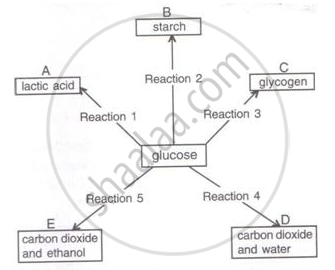Advertisements
Advertisements
Question
Describe and name three stages of cellular respiration that aerobic organisms use to obtain energy from glucose.
Solution 1
The three stages of Aerobic respiration are:
- Glycolysis (Glucose splitting): It is the breakdown of one molecule of glucose into two molecules of pyruvic acid. Glycolysis takes place in the cytoplasm of the cell. It is the first step of both aerobic and anaerobic respiration.
- Krebs Cycle: This cycle occurs in the mitochondria matrix. At the end of glycolysis, 2 molecules of pyruvic acid enter into mitochondria. The oxidation of pyruvic acid into CO2 and water takes place through this cycle. It is also called the Tricarboxylic Acid Cycle (TCA).
- Electron Transport Chain: This is accomplished through a system of electron carrier complex called electron transport chain (ETC) located on the inner membrane of the mitochondria. NADH2 and FADH2 molecules formed during glycolysis and Krebs cycle are oxidized to NAD+ and FAD+ to release the energy via electrons. As they move, the electrons release energy which is trapped by ADP to synthesis ATP. This is called oxidative phosphorylation. In this O2 gets reduced to water.
Solution 2
- Glycolysis
- Location: Cytoplasm of the cell
- Process:
- Glucose (a 6-carbon molecule) is broken down into two molecules of pyruvate (3-carbon molecules).
- This process does not require oxygen and occurs anaerobically as the first step.
- Glycolysis produces:
A net gain of 2 ATP molecules (4 ATP produced, 2 used)
2 NADH molecules (electron carriers)
- Summary:
\[\ce{Glucose(C6H12O6)->2 Pyruvate + 2 ATP + 2 NADH}\]
- Krebs Cycle (Citric Acid Cycle)
- Location: Mitochondrial matrix
- Process:
- The pyruvate molecules from glycolysis are converted into acetyl-CoA, which enters the Krebs cycle.
- In a series of enzyme-catalyzed reactions, acetyl-CoA is completely broken down into carbon dioxide (CO₂).
- Energy is captured in the form of:
2 ATP molecules
6 NADH molecules
2 FADH₂ molecules (another electron carrier)
- Summary:
\[\ce{2Acetyl-CoA -> 4CO2 + 2ATP + 6NADH + 2FADH2}\]
- Electron Transport Chain (ETC) and Oxidative Phosphorylation
- Location: Inner membrane of the mitochondria
- Process:
- The NADH and FADH₂ produced in earlier stages donate electrons to the electron transport chain.
- As electrons are passed along the chain, energy is released and used to pump protons (H⁺ ions) across the inner mitochondrial membrane, creating a proton gradient.
- Protons flow back through the enzyme ATP synthase, driving the production of ATP.
- Oxygen acts as the final electron acceptor, combining with electrons and protons to form water (H₂O).
- Outcome:
34 ATP molecules are produced through oxidative phosphorylation. - Summary:
\[\ce{NADH + FADH2 + O2 ->H2O + ATP}\]
APPEARS IN
RELATED QUESTIONS
Answer the following in one word.
Where does the exchange of gases take place?
State if the following statement is true or false. Correct the statement if it is false.
Anaerobic respiration takes place in our bones.
Given below are chemical reactions (1 to 5) involving glucose and five other chemical products (A-E).

Which reactions (1-5) in the above correspond to the following (write the corresponding number of reaction next to them).
(i) Aerobic respiration
(ii) Change taking place in the liver
(iii) Anaerobic respiration in yeast
(iv) Change taking place in a plant
storage organ, e.g., potato
(v) Anaerobic respiration in animals
Distinguish between:
Fermentation and anaerobic respiration.
Complete the following statement by choosing the correct alternative out of those given below.
In respiration, temperature
The question has four options. Choose the correct answer:
How many ATP molecules are gained in glycolysis?
The following identifies the electron acceptor present in the respiratory chain.
____________ ATPs will be effectively produced during the production of 1 molecule of acetyl-CoA from 1 molecule of pyruvic acid.
Identify the end products of pyruvic acid during alcoholic fermentation.
ATP is used in glycolysis to phosphorylate ______.
